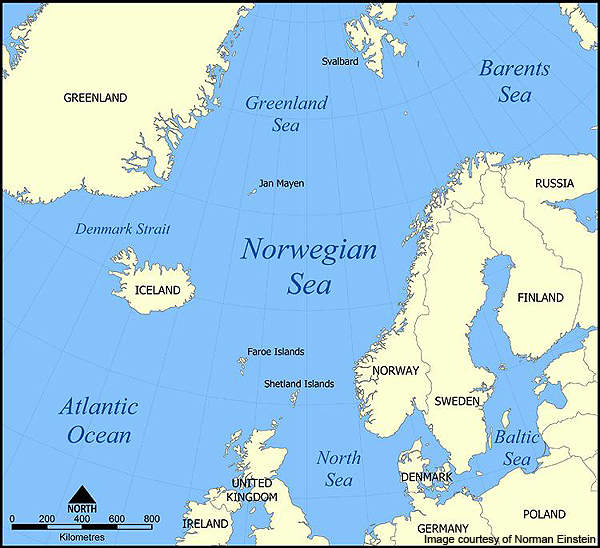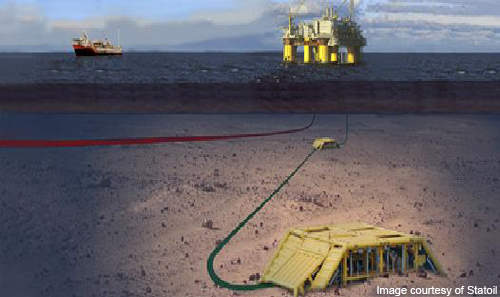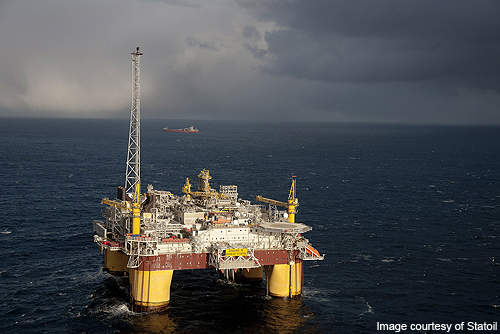Yttergryta is a subsea gas and condensate field located in the Norwegian North Sea. It is situated about 5km north of the Midgard deposit. The reservoir lies at a depth of 2,390m to 2,490m. Operator Statoil holds 45.75% interest in the field in partnership with Total (24.5%), Petoro (19.95%) and Eni (9.8%).
Discovery
The field was discovered by the exploration well 6507/11 – that was drilled by the Stena Don semi-submersible rig in July 2007. Gas resources were found in sandstones of the Jurassic age. The well was drilled at a water depth of 297m and temporarily plugged for future development.
Reserves
Recoverable reserves are estimated at 1.75bn m³ of gas with very low carbon dioxide content, 0.2m m³ of oil and 0.3Mt of natural gas liquids (NGLs).
Production
Yttergryta is currently producing through a single production well 6507/11-V-1H that was bored in October 2008. First production was in January 2009.
Field development
The field was developed with a subsea template on the seabed and a pipeline tied in to the Midgard-X template on the Asgard B platform. The total development cost was $170.5m. The plan for development and operation was approved in May 2008.
The process from discovery to production took approximately 18 months to complete. The fast realisation was achieved due to good knowledge of the subsurface in the area and usage of the existing infrastructure at the Asgard field.
Infrastructure
The field infrastructure includes a subsea template and a three mile long pipeline. The first major installation was completed by the deepwater Flex / J-lay vessel, Seven Seas, in August 2008. The vessel installed a 130Te PLEM, 25Te flowbase and 6km (3.7 miles) dual lay 3in umbilical, Methanol and Glycol (MEG) injection line and three spools.
In April 2009, Statoil signed a contract with SPT Group for the supply of an online Production Management System (PMS) covering the Yttergryta, Mikkel and Midgard subsea fields. The PMS will be configured in SPT Group’s online e-Field Solution based on OLGA multiphase flow simulator. OLGA is used to check and update procedures and ensure pro-active operations. It feeds online real-time data into the simulator to supply accurate look-ahead predictions.
The PMS controls the MEG injection and risk for hydrate formation. It also controls the liquid accumulations during low rates of production and the subsequent liquid surge volumes released from the line during high rates of production. The electronic data processing machine (EDPM) operates in four modes including real-time, look-ahead, planning and look-back.
FMC was awarded an engineering, procurement and construction (EPC) contract to supply the subsea gas compression control systems for the field in 2007. FMC also provided the subsea production system, integrated satellite structure, pipeline end manifold, flowbase and a 6km umbilical for the field.
Floating production platform
The Asgard B floating gas production platform (FPU) is being used for the Yttergryta gas and condensate. The FPU is the world’s largest of its kind, with a weight of 30,865t. It collects gas from the Midgard, Smorbukk and Smorbukk South accumulations.
The platform has a six-column semisub with a rig pontoon facility with approximately 89,287t displacement.
The daily production capacity of the FPU is 1.3bn ft³/d of natural gas and 94,000bpd of condensate.
A seabed compressor will be installed at the platform to increase pressure on the field in 2012 / 2013.
The subsea compressor will increase gas production by 25% and ensure production until 2021.
Export
The field is currently producing via pressure depletion. Production is being regulated by the demand on the Asgard field. The produced gas is first transported to the Midgard X-template and then to Asgard B for processing.
The gas, containing very little CO2, will be mixed with the export gas in Asgard Transport System.










